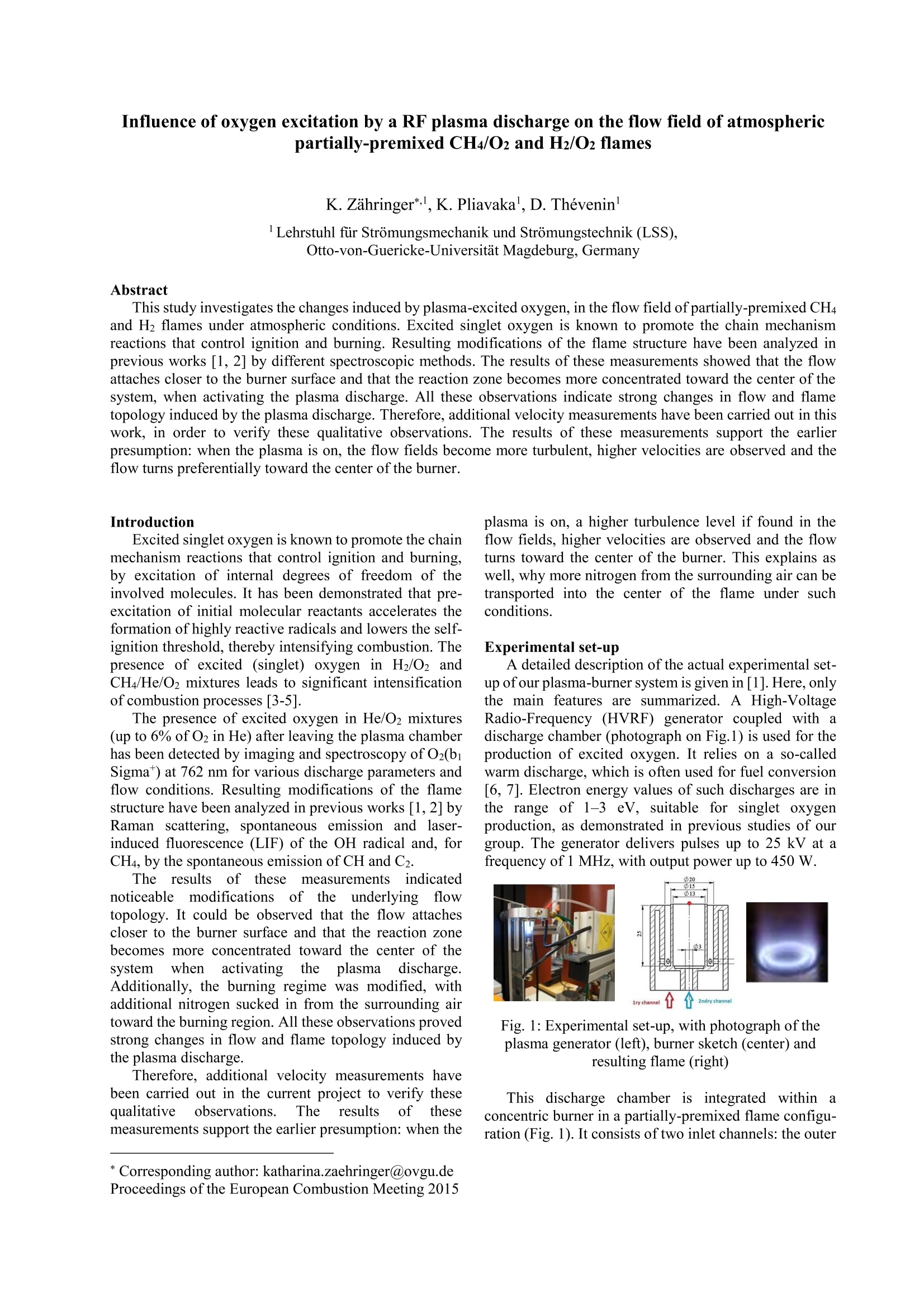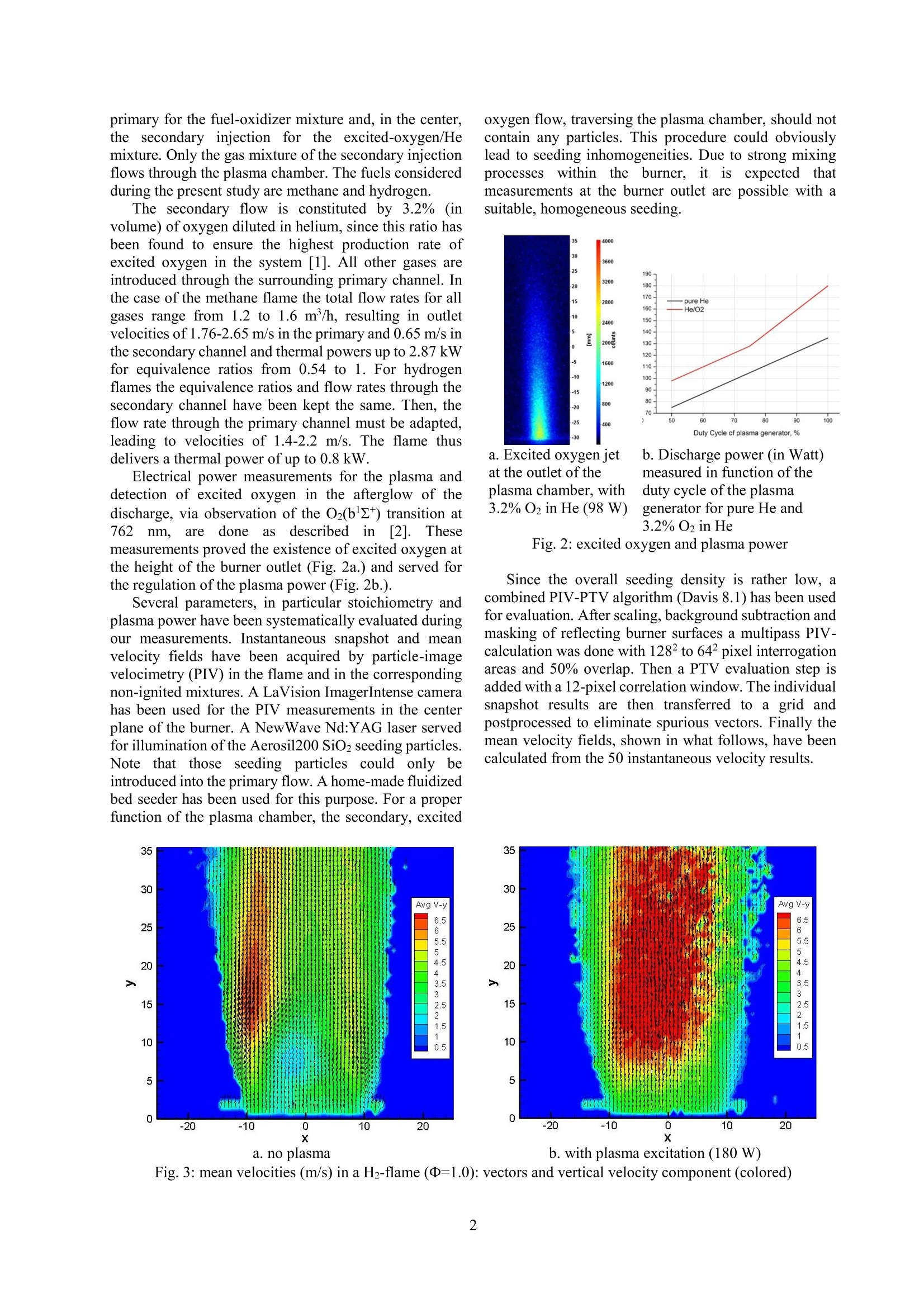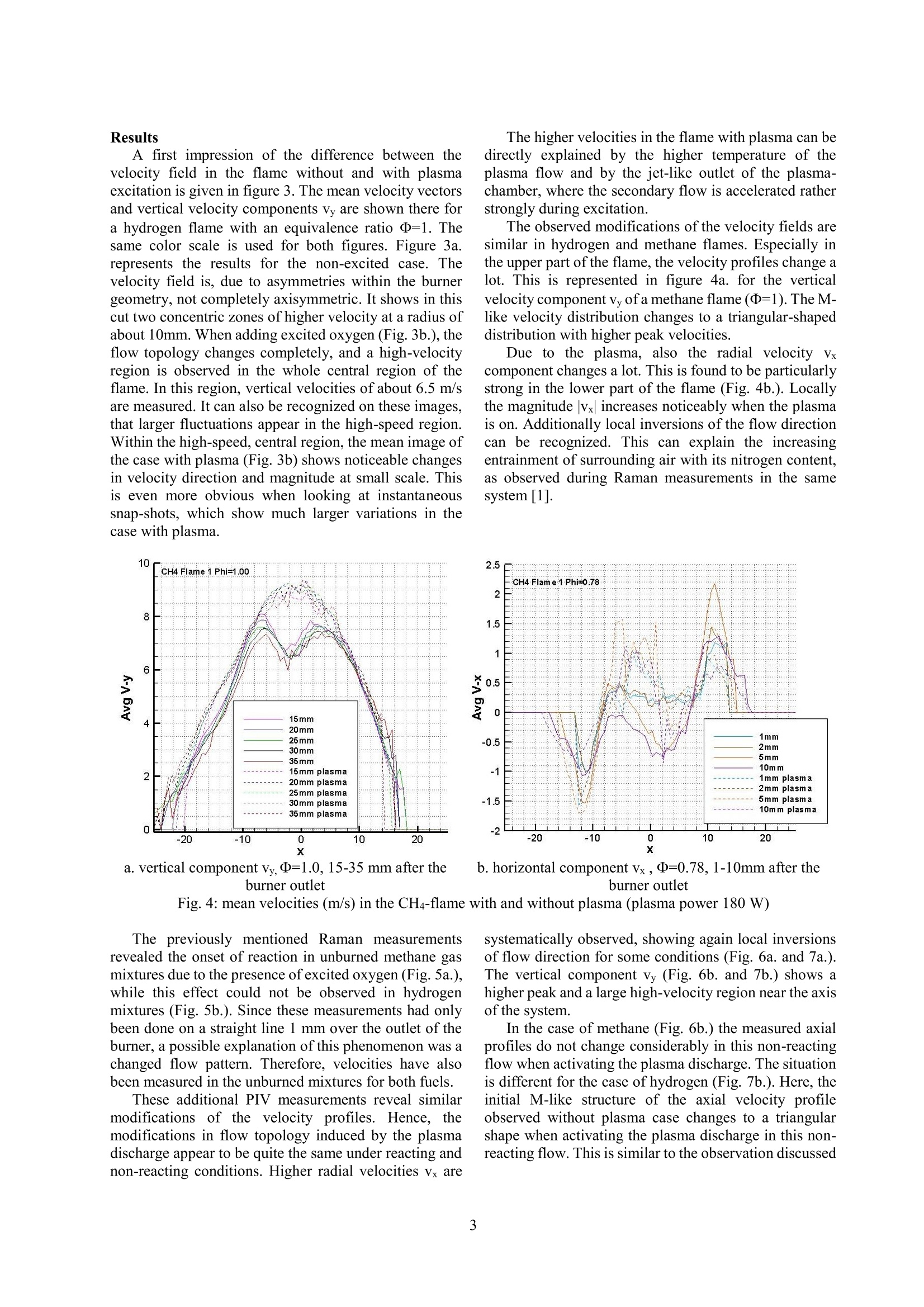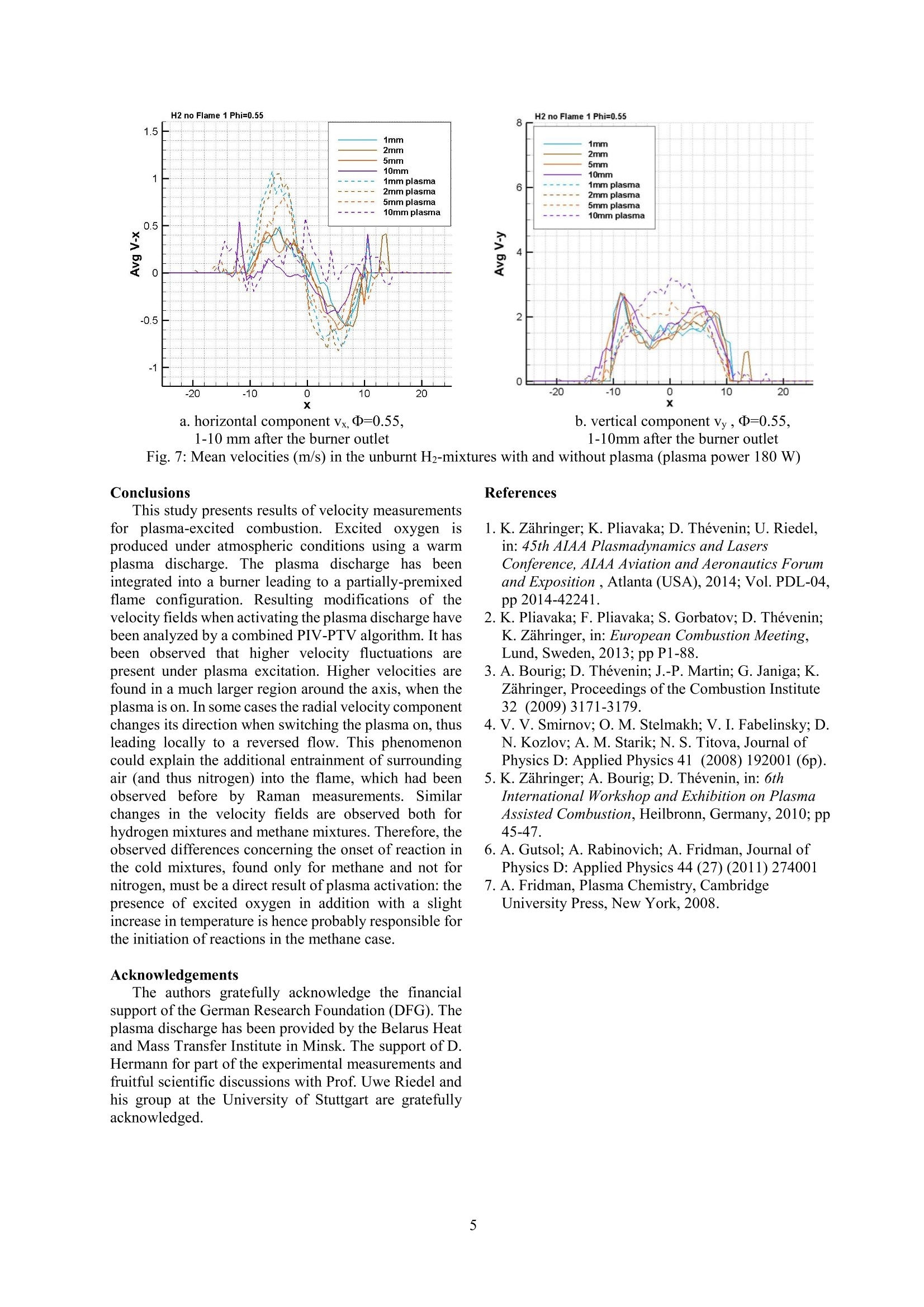方案详情
文
采用LaVision的ImagerIntense型CCD相机和NewWavePIV激光器对甲烷加氧气和氢气加氧气两种燃料混合物火焰流场进行了测量,并研究观察了高压高频放电对流场形态,燃烧形态的影响,分析了影响机理,并探讨了可能的应用。
方案详情

Influence of oxygen excitation by a RF plasma discharge on the flow field of atmosphericpartially-premixed CH4/Oz and H2/O2 flames K. Zahringer*., K. Pliavaka, D. Thevenin Lehrstuhl fur Stromungsmechanik und Stromungstechnik (LSS),Otto-von-Guericke-Universitat Magdeburg, Germany Abstract This study investigates the changes induced by plasma-excited oxygen, in the flow field of partially-premixed CH4and H flames under atmospheric conditions. Excited singlet oxygen is known to promote the chain mechanismreactions that control ignition and burning. Resulting modifications of the flame structure have been analyzed inprevious works [1, 2] by different spectroscopic methods. The results of these measurements showed that the flowattaches closer to the burner surface and that the reaction zone becomes more concentrated toward the center of thesystem, when activating the plasma discharge. All these observations indicate strong changes in flow and flametopology induced by the plasma discharge. Therefore, additional velocity measurements have been carried out in thiswork, in order to verify these qualitative observations. The results of these measurements support the earlierpresumption: when the plasma is on, the flow fields become more turbulent, higher velocities are observed and theflow turns preferentially toward the center of the burner. Introduction Excited singlet oxygen is known to promote the chainmechanism reactions that control ignition and burning,by excitation of internal degrees of freedom of theinvolved molecules. It has been demonstrated that pre-excitation of initial molecular reactants accelerates theformation of highly reactive radicals and lowers the self-ignition threshold, thereby intensifying combustion. Thepresence of excited (singlet) oxygen in H2/O2 andCH4/He/O2 mixtures leads to significant intensificationof combustion processes [3-5]. The presence of excited oxygen in He/O2 mixtures(up to 6% of O2 in He) after leaving the plasma chamberhas been detected by imaging and spectroscopy of O2(biSigma) at 762 nm for various discharge parameters andflow conditions. Resulting modifications of the flamestructure have been analyzed in previous works [1, 2] byRaman scattering, spontaneous emission and laser-induced fluorescence (LIF) of the OH radical and, forCH4, by the spontaneous emission of CH and C2. The resultsof thesemeasurementsindicatednoticeablemodificationsofttheunderlyingflowtopology. It could be observed that the flow attachescloser to the burner surface and that the reaction zonebecomes more concentrated toward the center of thesystem when activating the plasma discharge.Additionally, the burning regime was modified, withadditional nitrogen sucked in from the surrounding airtoward the burning region. All these observations provedstrong changes in flow and flame topology induced bythe plasma discharge. Therefore, additional velocity measurements havebeen carried out in the current project to verify thesequalitative observations.TThe results of tthesemeasurements support the earlier presumption: when the ( * Corresponding author: katharina.zaehringer@ovgu.deProceedings of the European Combustion M e eting 2015 ) plasma is on, a higher turbulence level if found in theflow fields, higher velocities are observed and the flowturns toward the center of the burner. This explains aswell, why more nitrogen from the surrounding air can betransported into the center of the flame under suchconditions. Experimental set-up A detailed description of the actual experimental set-up of our plasma-burner system is given in [1]. Here, onlythe main features are summarized. A High-VoltageRadio-Frequency (HVRF) generator coupled with adischargechamber (photograph on Fig. 1) is used for theproduction of excited oxygen. It relies on a so-calledwarm discharge, which is often used for fuel conversion[6, 7]. Electron energy values of such discharges are inthe range of 1-3 eV, suitable for singlet oxygenproduction, as demonstrated in previous studies of ourgroup. The generator delivers pulses up to 25 kV at afrequency of 1 MHz, with output power up to 450 W. Fig. 1: Experimental set-up, with photograph of theplasma generator (left), burner sketch (center) andresulting flame (right) This discharge chamber is integrated1 within aconcentric burner in a partially-premixed flame configu-ration (Fig. 1). It consists of two inlet channels: the outer primary for the fuel-oxidizer mixture and, in the center,the secondary injection for the excited-oxygen/Hemixture. Only the gas mixture of the secondary injectionflows through the plasma chamber. The fuels consideredduring the present study are methane and hydrogen. The secondary flow is constituted by 3.2% (involume) of oxygen diluted in helium, since this ratio hasbeen found to ensure the highest production rate ofexcited oxygen in the system [1]. All other gases areintroduced through the surrounding primary channel. Inthe case of the methane flame the total flow rates for allgases range from 1.2 to 1.6 m/h, resulting in outletvelocities of 1.76-2.65 m/s in the primary and 0.65 m/s inthe secondary channel and thermal powers up to 2.87 kWfor equivalence ratios from 0.54 to 1. For hydrogenflames the equivalence ratios and flow rates through thesecondary channel have been kept the same. Then, theflow rate through the primary channel must be adapted,leading to velocities of 1.4-2.2 m/s. The flame thusdelivers a thermal power of up to 0.8kW. Electrical power measurements for the plasma anddetection of excited oxygen in the afterglow of thedischarge, via observation of the O2(b) transition at762nm,aredoneeasdescribed in [2]. Thesemeasurements proved the existence of excited oxygen atthe height of the burner outlet (Fig. 2a.) and served forthe regulation of the plasma power (Fig. 2b.). Several parameters, in particular stoichiometry andplasma power have been systematically evaluated duringour measurements. Instantaneous snapshot and meanvelocity fields have been acquired by particle-imagevelocimetry (PIV) in the flame and in the correspondingnon-ignited mixtures. A LaVision ImagerIntense camerahas been used for the PIV measurements in the centerplane of the burner. A NewWave Nd:YAG laser servedfor illumination of the Aerosil200 SiO2 seeding particles.Note that those seeding particles could only beintroduced into the primary flow. A home-made fluidizedbed seeder has been used for this purpose. For a properfunction of the plasma chamber, the secondary, excited oxygen flow, traversing the plasma chamber, should notcontain any particles. This procedure could obviouslylead to seeding inhomogeneities. Due to strong mixingprocesseswithinn the1ebburner, itis expected thatmeasurements at the burner outlet are possible with asuitable, homogeneous seeding. 3600 a. Excited oxygen jet at the outlet of the plasma chamber, with 3.2%O2 in He (98 W) b. Discharge power (in Watt)measured in function of theduty cycle of the plasmagenerator for pure He and3.2%O2 in He Fig.2: excited oxygen and plasma power Since the overall seeding density is rather low, acombined PIV-PTV algorithm (Davis 8.1) has been usedfor evaluation. After scaling, background subtraction andmasking of reflecting burner surfaces a multipass PIV-calculation was done with 128 to 642 pixel interrogationareas and 50% overlap. Then a PTV evaluation step isadded with a 12-pixel correlation window. The individualsnapshot results are then transferred to a grid andpostprocessed to eliminate spurious vectors. Finally themean velocity fields, shown in what follows, have beencalculated from the 50 instantaneous velocity results. a. no plasma b. with plasma excitation (180 W) Fig. 3: mean velocities (m/s) in a H2-flame (=1.0): vectors and vertical velocity component (colored) Results A first impression of the difference between thevelocity field in the flame without and with plasmaexcitation is given in figure 3. The mean velocity vectorsand vertical velocity components Vy are shown there fora hydrogen flame with an equivalence ratio D=1. Thesame color scale is used for both figures. Figure 3a.represents the results for the non-excited case. Thevelocity field is, due to asymmetries within the burnergeometry, not completely axisymmetric. It shows in thiscut two concentric zones of higher velocity at a radius ofabout 10mm. When adding excited oxygen (Fig. 3b.), theflow topology changes completely, and a high-velocityregion is observed in the whole central region of theflame. In this region, vertical velocities of about 6.5 m/sare measured. It can also be recognized on these images,that larger fluctuations appear in the high-speed region.Within the high-speed, central region, the mean image ofthe case with plasma (Fig. 3b) shows noticeable changesin velocity direction and magnitude at small scale. Thisis even more obvious when looking at instantaneoussnap-shots, which show much larger variations in thecase with plasma. The previously mentioned Raman measurementsrevealed the onset of reaction in unburned methane gasmixtures due to the presence of excited oxygen (Fig. 5a.),while this effect could not be observed in hydrogenmixtures (Fig. 5b.).Since these measurements had onlybeen done on a straight line 1 mm over the outlet of theburner, a possible explanation of this phenomenon was achanged flow pattern. Therefore, velocities have alsobeen measured in the unburned mixtures for both fuels. These additional PIV measurements reveal similarmodifications of the velocity profiles. Hence, themodifications in flow topology induced by the plasmadischarge appear to be quite the same under reacting andnon-reacting conditions. Higher radial velocities Vx are The higher velocities in the flame with plasma can bedirectly explained by the higher temperature of theplasma flow and by the jet-like outlet of the plasma-chamber, where the secondary flow is accelerated ratherstrongly during excitation. The observed modifications of the velocity fields aresimilar in hydrogen and methane flames.Especially inthe upper part of the flame, the velocity profiles change alot. This is represented in figure 4a. for the verticalvelocity component Vy of a methane flame (D=1). The M-like velocity distribution changes to a triangular-shapeddistribution with higher peak velocities. Due to the plasma, also the radial velocity vxcomponent changes a lot. This is found to be particularlystrong in the lower part of the flame (Fig. 4b.). Locallythe magnitude |vx|increases noticeably when the plasmais on. Additionally local inversions of the flow directioncan be recognized. This can explain the increasingentrainment of surrounding air with its nitrogen content,as observed during Raman measurements in the samesystem [1]. Fig. 4: mean velocities (m/s) in the CH4-flame with and without plasma (plasma power 180 W) systematically observed, showing again local inversionsof flow direction for some conditions (Fig. 6a. and 7a.).The vertical component Vy (Fig. 6b.and 7b.) shows ahigher peak and a large high-velocity region near the axisof the system. In the case of methane (Fig. 6b.) the measured axialprofiles do not change considerably in this non-reactingflow when activating the plasma discharge. The situationis different for the case of hydrogen (Fig. 7b.). Here, theinitial M-like structure of the axial velocity profileobserved without plasma case changes to a triangularshape when activating the plasma discharge in this non-reacting flow. This is similar to the observation discussed in connection with figure 4a for the burning methaneflame. It appears that modifications in flow topology are notresponsible for the onset of reaction observed in the non-reacting methane flow when activating the discharge.Therefore, this observation should be a result of pure kinetics. The presence of excited oxygen and the slightincreaseirint temperature, botthhinduced by plasmaactivation, appear to be responsible for the onset ofreaction in the methane flow, while they are not sufficientto initiate reaction in the hydrogen flow. 128W 180W c Fig.5: Mean Raman spectra of the non-ignited mixtures (中=0.55) for different power inputs Fig. 6: Mean velocities (m/s) in the unburnt CH4-mixtures with and without plasma (plasma power 180 W) 1-10 mm after the burner outlet b. vertical component Vy,D=0.55,1-10mm after the burner outlet Fig. 7: Mean velocities (m/s) in the unburnt H2-mixtures with and without plasma (plasma power 180 W) This study presents results of velocity measurementsfor plasma-excited combustion. Excited oxygenisproduced under atmospheric conditions using a warmplasma discharge. The plasma discharge has beenintegrated into a burner leading to a partially-premixedflame configuration. Resulting modifications of thevelocity fields when activating the plasma discharge havebeen analyzed by a combined PIV-PTV algorithm. It hasbeen observed that higher velocity fluctuations arepresent under plasma excitation. Higher velocities arefound in a much larger region around the axis, when theplasma is on. In some cases the radial velocity componentchanges its direction when switching the plasma on, thusleading locally to a reversed flow. This phenomenoncould explain the additional entrainment of surroundingair (and thus nitrogen) into the flame, which had beenobserved before by Raman measurements. Similarchanges in the velocity fields are observed both forhydrogen mixtures and methane mixtures.Therefore, theobserved differences concerning the onset of reaction inthe cold mixtures, found only for methane and not fornitrogen, must be a direct result of plasma activation: thepresence of excited oxygen in addition with a slightincrease in temperature is hence probably responsible forthe initiation of reactions in the methane case. Acknowledgements The authors gratefully acknowledge the financialsupport of the German Research Foundation (DFG). Theplasma discharge has been provided by the Belarus Heatand Mass Transfer Institute in Minsk. The support of D.Hermann for part of the experimental measurements andfruitful scientific discussions with Prof. Uwe Riedel andhis group at the University of Stuttgart are gratefullyacknowledged. References ( 1. K. Zahringer; K. Pliavaka; D. Thevenin; U. Riedel, in: 45th AIAA Plasmadynamics and Lasers Conference, AIAA Aviation and Aeronautics Forum and Exposition, A tlanta (USA), 2 014; Vol. PDL-04,pp 2014-42241. ) 2.K. Pliavaka; F. Pliavaka; S. Gorbatov; D. Thevenin;K. Zahringer, in: European Combustion Meeting,Lund, Sweden, 2013; ppP1-88. 3. A. Bourig; D. Thevenin; J.-P.Martin; G. Janiga; K.Zahringer, Proceedings of the Combustion Institute32 (2009)3171-3179. ( 4. V. V. Smirnov; O. M. Stelmakh; V. I. Fabelinsky; D.N. K ozlov; A. M. Starik; N. S . Titova, Journal of P hysics D: Applied Physics 41 (2008)192001 (6p). ) ( 5. K. Zahringer; A. Bourig; D. T hevenin, in: 6thInternational Workshop and Exhibition on PlasmaAssisted Combustion, Heilbronn, Germany, 2010; pp 45-47. ) ( 6 . A. Gutsol; A. Rabinovich; A. F ridman, Journal ofPhysics D : A pplied Physics 44 (27) (2011) 274001 ) ( 7 . A. Fridman, Plasma Chemistry, CambridgeUniversity Press, New Y ork, 2008. ) This study investigates the changes induced by plasma-excited oxygen, in the flow field of partially-premixed CH4and H2 flames under atmospheric conditions. Excited singlet oxygen is known to promote the chain mechanismreactions that control ignition and burning. Resulting modifications of the flame structure have been analyzed inprevious works [1, 2] by different spectroscopic methods. The results of these measurements showed that the flowattaches closer to the burner surface and that the reaction zone becomes more concentrated toward the center of thesystem, when activating the plasma discharge. All these observations indicate strong changes in flow and flametopology induced by the plasma discharge. Therefore, additional velocity measurements have been carried out in thiswork, in order to verify these qualitative observations. The results of these measurements support the earlierpresumption: when the plasma is on, the flow fields become more turbulent, higher velocities are observed and theflow turns preferentially toward the center of the burner.
确定





还剩3页未读,是否继续阅读?
北京欧兰科技发展有限公司为您提供《部分预混合CH4/O2和H2/O2火焰中火焰流场流动检测方案(粒子图像测速)》,该方案主要用于其他中火焰流场流动检测,参考标准--,《部分预混合CH4/O2和H2/O2火焰中火焰流场流动检测方案(粒子图像测速)》用到的仪器有德国LaVision PIV/PLIF粒子成像测速场仪、LaVision DaVis 智能成像软件平台
推荐专场
相关方案
更多
该厂商其他方案
更多
















